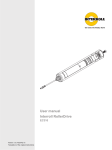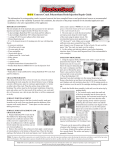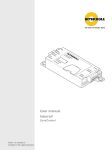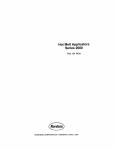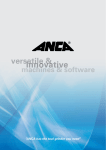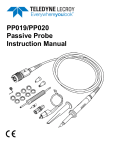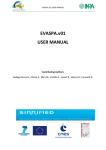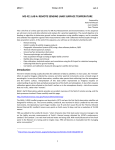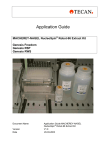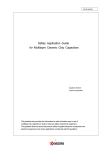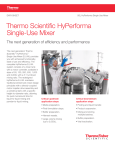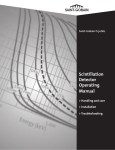Download DYNAFOAM® - Saint-Gobain Performance Plastics Foams
Transcript
DYNAFOAM® T e c h n i ca l G u i d e DYNAFOAM® is a proud member of the NORSEAL® family. 2 ® Dynafoam Technical Guide CONTENT Content ................................................................................................................................................................... 3 List of illustrations ................................................................................................................................................... 5 Introduction ............................................................................................................................................................ 6 1. 2. 3. What is DYNAFOAM® ...................................................................................................................................... 7 1.1 Definition ............................................................................................................................................... 7 1.2 Packaging, storage, shelf life ................................................................................................................. 7 Principal implementation properties .............................................................................................................. 8 2.1 Sensitivity to heat .................................................................................................................................. 8 2.2 Mono-component and thermoplastic ................................................................................................... 9 2.3 Curing in response to temperature and relative humidity .................................................................. 10 2.4 Density determines some of the gasket properties ............................................................................ 10 2.5 Post foaming ........................................................................................................................................ 11 2.6 Viscosity according to temperature .................................................................................................... 12 Implementation ............................................................................................................................................ 12 3.1 Nordson machine – general information ............................................................................................ 12 3.2 Changing dynafoam® drums ................................................................................................................ 13 3.3 Foaming instruction ............................................................................................................................. 15 3.3.1 Nordson machine ............................................................................................................................ 15 3.3.2 General information ........................................................................................................................ 16 3.4 Application ........................................................................................................................................... 16 3.4.1 Dispensing head .............................................................................................................................. 16 3.4.2 Application methods ....................................................................................................................... 17 3.5 Curing................................................................................................................................................... 18 3.5.1 Humidity/moisture (between 45% & 85%) ..................................................................................... 18 3.5.2 Temperature (between 40°C & 55°C) ............................................................................................. 18 3.5.3 Ambient temperature (room temperature) .................................................................................... 19 DYNAFOAM® is a proud member of the NORSEAL® family. 3 ® Dynafoam Technical Guide 3.5.4 Curing time ...................................................................................................................................... 19 3.6 4. Recommendations ............................................................................................................................... 20 Parameters affecting the appearance & quality of the gasket ..................................................................... 20 4.1 Temperature: ....................................................................................................................................... 20 4.2 The percentage of gas: ........................................................................................................................ 20 4.3 Pressure: .............................................................................................................................................. 20 4.4 The mixer: ............................................................................................................................................ 21 4.5 Inadequate purging: ............................................................................................................................ 22 4.6 The nozzle: ........................................................................................................................................... 22 5. Maintenance ................................................................................................................................................. 23 6. Repairs/troublshooting and faq .................................................................................................................... 24 6.1 Product repairs/troubleshooting ......................................................................................................... 24 6.1.1 Particles ........................................................................................................................................... 24 6.1.2 Damaged skin .................................................................................................................................. 24 6.1.3 Bubble or large cells ........................................................................................................................ 25 6.1.4 Poor/incorrect transfer moulding ................................................................................................... 25 6.1.5 Poor appearance of the gasket ....................................................................................................... 26 6.1.6 Waves in the skin ............................................................................................................................ 26 6.1.7 Stretch marks on the skin ................................................................................................................ 26 6.1.8 Uneven gasket height ...................................................................................................................... 26 6.1.9 Other repairs/troubleshooting ........................................................................................................ 27 6.2 Faq’s..................................................................................................................................................... 28 DYNAFOAM® is a proud member of the NORSEAL® family. 4 ® Dynafoam Technical Guide LIST OF ILLUSTRATIONS Figure 1 : Density measurment test method ........................................................................................................ 11 Figure 2 : Nordson Machine .................................................................................................................................. 12 Figure 3 : Instruction label for changing a drum ................................................................................................... 14 Figure 4 : Nordson Machine .................................................................................................................................. 15 Figure 5 : Direct extrusion ..................................................................................................................................... 17 Figure 6 : Transfer Moulding ................................................................................................................................. 17 Figure 7 : Example of a high humidity drying oven ............................................................................................... 18 Figure 8 : Excess foaming ...................................................................................................................................... 21 Figure 9 : Density that is too high ......................................................................................................................... 21 Figure 10 : nozzle too far from the substrate ....................................................................................................... 22 Figure 11 : Gas injection valve .............................................................................................................................. 23 Figure 12 : Assembly prior to complete curing ..................................................................................................... 24 Figure 13 : Humidity damaging the skin ................................................................................................................ 26 Table 1 : General aspects of these thermoplastic products .................................................................................... 9 Table 2 : Principal foaming parameters ................................................................................................................ 15 Table 3 : Viscosity and nozzle diameter ................................................................................................................ 16 Table 4 : Summary for all products ....................................................................................................................... 19 Table 5 : Application temperatures....................................................................................................................... 24 DYNAFOAM® is a proud member of the NORSEAL® family. 5 ® Dynafoam Technical Guide INTRODUCTION The aim of this application manual is to guide partners and customers through the use of SaintGobain’s Dynafoam® solution. It is designed to provide general as well as precise information on phenomena and technical data, along with advice and recommendations. Initially, you will learn about Dynafoam® and the resulting foam-in-place gasketing solution. We will then turn to the key properties of the product for its implementation. In a more technical section, we will then deal with the implementation process and the different pieces of equipment required. The quality of the foamed gasket will subsequently become the focus of our attention, with examples and influential factors. A fifth section, on maintenance, will include recommendations and advice that are independent of the manufacturer’s recommendations. And, to conclude, an FAQ section will be provided to help you use this solution. NB.: This manual is not a replacement for the technical specifications, the DYNAFOAM® documentation or the documentation for the foaming machine. DYNAFOAM® is a proud member of the NORSEAL® family. 6 ® Dynafoam Technical Guide 1. WHAT IS DYNAFOAM® 1.1 DEFINITION DYNAFOAM® is the name of a flexible watertight foam-in-place gasket developed by Saint-Gobain. Its main characteristics in an unfoamed state (as received by the customer) are as follows: • A mono-component product (PUR 1K) • Thermoplastic • Physically foamed with nitrogen (humidity/moisture must be below 5 ppm) • Applied in-place • Cured by its reaction with the humidity/moisture in ambient air • Vacuum packed in a contamination-free multilayer bag • Supplied in 20 or 200 litre metal drums (or in reusable plastic containers for 20 litre deliveries) This technology from Saint-Gobain has been helping industrial operators for almost 30 years. As it is constantly evolving, one development follows another, enabling you to monitor and anticipate your customers’ needs. 1.2 PACKAGING, STORAGE, SHELF LIFE DYNAFOAM® is packaged in drums, containing a vacuum packed moisture-sealed bag. Each drum bears a label containing the following information: a. The type of DYNAFOAM® b. The quantity of material in kg c. The batch number d. The expiration date e. The maximum application temperature (which must never be exceeded!) DYNAFOAM® is a proud member of the NORSEAL® family. 7 ® Dynafoam Technical Guide Material stocks must be managed by applying the FIFO principle (First In First Out). The temperature in the Dynafoam® storage area must not exceed 30°C and drums must be kept out of direct sunlight. DYNAFOAM® has a shelf life of 6 months from its date of manufacture in normal storage conditions (ambient temperature and under cover). It should be noted that the product’s viscosity increases during storage, but this phenomenon does not radically alter its properties, even after a period of 6 months. 6 months is given as a reasonable limit for using the product without any quality issues and offering optimum processability. Nevertheless, we strongly recommend using the product within this period. Any claims/complaints relating to a product that has exceeded its expiration date will be rejected by Saint-Gobain. 2. PRINCIPAL IMPLEMENTATION PROPERTIES 2.1 SENSITIVITY TO HEAT DYNAFOAM® is sensitive to heat. We recommend shutting off the system’s heating in the event of a stoppage lasting for more than 30 minutes. This will prevent accelerated ageing of the product, which could cause problems with pumping or particles. For each stoppage lasting for more than 1 hour, it is necessary to purge the system (the quantity of ® product present in the mixer and in the hose between the mixer and the head) as the Dynafoam and nitrogen mixture will no longer be uniform. In the event of a stoppage lasting between 15 and 30 minutes, discharge a quantity equivalent to one part, in order to prevent excess pressure building up at the nozzle, thereby impairing the quality of foaming and/or damaging the nozzle needle. Clean the heating platen every time the drum is changed. This cleaning helps prevent cured product being transferred from the versa drum to the nozzle. Do not exceed the mixer’s recommended speed. This could result in an increase in dynamic shear and, because of this, in excess foaming as well as a rise in temperature. Temperature changes the viscosity, which, itself, has an effect on the quality of the foam and smooth operation of the system. DYNAFOAM® is a proud member of the NORSEAL® family. 8 ® Dynafoam 2.2 Technical Guide MONO-COMPONENT AND THERMOPLASTIC DYNAFOAM® is designed to be automatically applied in-place to create foamed gaskets. It reacts with the humidity/moisture in ambient air to acquire elastomeric properties, as well as those required for smooth application. These products need to be heated in order to be pumped because of their viscosity. In addition, cooling them creates the cohesion needed for them to retain the desired shape. Finally, curing them gives them the required elasticity, chemical resistance and thermal resistance. Product 512 7440 Series Base Polyester base Polyether base With a high humidity drying oven Between 350 & 400 Between 220 & 280 Thixotropy Very high High Height/width ratio 0.9 0.65 Application Temperature Between 70° & 80° Between 30° & 40° 3D application yes yes Density (kg/m³) Table 1 : General aspects of these thermoplastic products DYNAFOAM® is a proud member of the NORSEAL® family. 9 ® Dynafoam 2.3 Technical Guide CURING IN RESPONSE TO TEMPERATURE AND RELATIVE HUMIDITY DYNAFOAM® reacts to temperature and relative humidity, forming a three-dimensional structure. The curing time for this product depends on various parameters, including: • initial density (close to 1,100 kg/m³), • the diameter and shape of the gasket, • physical configuration (presence of a groove or not), • curing conditions (temperature and relative humidity). Curing will be quicker if the gasket’s diameter is smaller at a high temperature and, above all, with high humidity. 2.4 DENSITY DETERMINES SOME OF THE GASKET PROPERTIES The properties that are determined (wholly or in part) by density are: • Hardness and compression force, • Curing speed, which is inversely proportional to density, • The size of the gasket • Compression set Density and hardness are not systematically related when comparing two chemically different products. One product may have a compression force (and/or hardness) that is lower than another, which has stronger chemical bonds. In this respect, it is important to check the density following complete curing of the DYNAFOAM® gasket, in order to verify the latter’s properties. In addition, this check enables you to see whether the density of the gasket is stable throughout production (i.e. the machine is operating normally). To do this, Saint-Gobain proposes using the following verification method: 1. Cut off a ± 3 cm long strand. Do not squeeze it. 2. Calibrate the scales and weigh the sample to the nearest 1/100 g. Note the weight (A = in grams). 3. Hang a plumb line with a needle from the bottom of the scales. 4. Place a beaker filled with water on the scales’ lower plate. DYNAFOAM® is a proud member of the NORSEAL® family. 10 ® Dynafoam Technical Guide 5. Dip the lead weight and the needle into the water, without touching the walls of the beaker. 6. Calibrate the scales. 7. Lift up the lead weight and the needle and hang the previously weighed sample piece on it. 8. Dip all of this into the water, without touching the walls. Note the weight of the sample in the water (B = grams). Density (kg/lit) = A (= gram) A (= gram) – B (= gram) Figure 1 : Density measurment test method 2.5 POST FOAMING The gasket leaving the nozzle is subject to a pressure drop, which makes it foam as a result of the expansion of the nitrogen trapped within it. In addition, once the gasket is extruded, it reacts chemically with the humidity/moisture in the air; this is known as “post foaming”. This chemical reaction generates CO2, which makes the gasket swell to its final size. The extent of post foaming also depends on various parameters: • The diameter of the initial gasket, • Curing speed, • Relative humidity, • Temperature. Therefore, it is important to take post foaming into account, in order to obtain the desired dimensions and shapes. DYNAFOAM® is a proud member of the NORSEAL® family. 11 ® Dynafoam 2.6 Technical Guide VISCOSITY ACCORDING TO TEMPERATURE DYNAFOAM® is a thermoplastic material and its viscosity changes in a manner that is inversely proportional to temperature. This means that viscosity decreases as the temperature rises and vice versa. In the event of too much shear (specifically in terms of the mixer), the temperature will rise but the shear stresses will increase the product’s viscosity. 3. IMPLEMENTATION 3.1 NORDSON MACHINE – GENERAL INFORMATION Figure 2 : Nordson Machine The Nordson machine is made up of four units: - The drum unloader The drum unloader enables the product’s viscosity to be reduced in order to pump it. It loads the equipment with material, by pumping it from the metal drum to the foaming machine. - The foaming machine Comprising two pumps with their speeds adjusted to the foaming ratio, it enables nitrogen to be incorporated into the Dynafoam® product using the dynamic mixer. DYNAFOAM® is a proud member of the NORSEAL® family. 12 ® Dynafoam - Technical Guide The extrusion head This allows the quantity of product to be deposited to be measured. - The control panel The control panel contains all the modifiable parameters, as well as information on the process. It allows the settings to be changed in order to influence the product/nitrogen mixture as well as the quantities extruded. 3.2 CHANGING DYNAFOAM® DRUMS For optimum use, care must be taken not to damage drums during storage and handling. The condition of Dynafoam® drums is checked by Saint-Gobain and carriers leaving the factory, to ensure that drums despatched by Saint-Gobain are clean and smooth, with no dents. The carrier is liable for damage caused during transport. We strongly recommend checking the condition of drums when the material is received and, should any damaged be observed, do not hesitate to reject them or, failing this, to have the carrier sign a document stating clearly the damaged condition of the drums (with a photograph, if possible). SaintGobain will not bear the costs of drums damaged by the carrier. DYNAFOAM® is a proud member of the NORSEAL® family. 13 ® Dynafoam Technical Guide To change a DYNAFOAM® drum, simply follow the instructions appearing on the label affixed to the lid of each drum. Figure 3 : Instruction label for changing a drum For your safety, follow the machine manufacturer’s instructions (see the user manual). Every time a drum is changed, clean away product residue from beneath the platen as well as the platen’s seals (“O-ring”) using a plastic spatula, in order to prevent cured material entering the system and damaging the various coatings. It is also feasible to place a thin layer of grease on the “O-ring” seals, in order to facilitate insertion of the platen. DYNAFOAM® is a proud member of the NORSEAL® family. 14 ® Dynafoam 3.3 Technical Guide FOAMING INSTRUCTION 3.3.1 NORDSON MACHINE Our tests and prototyping phase were carried out using a Nordson “Ultra Foam Mix” laboratory machine with a 20 lit vacuum “Versa Drum” drum. Figure 4 : Nordson Machine The following parameters are generic parameters observed during our various studies. Product 512 7440 Series Gas set point Between 26% & 32% Between 35 & 45% Target density Between ±350 kg/m³ & ±450 kg/m³ Between ±220 kg/m³ & ±240 kg/m³ Gas pressure 6 bar 6 bar Product pressure Between 60 & 80 bars Between 60 & 80 bars Mixer speed Between 60 & 80 rpm Between 60 & 80 rpm Application T° Between 70° & 80℃ Between 30° & 40℃ Table 2 : Principal foaming parameters These figures are provided for information only. The parameters need to be adjusted for each application, in order to obtain an optimal result. There will be vast differences between curing in ambient conditions and curing in a high humidity drying oven. DYNAFOAM® is a proud member of the NORSEAL® family. 15 ® Dynafoam 3.3.2 Technical Guide GENERAL INFORMATION For initial adjustment, you must always measure the density of the foam and adjust the settings accordingly. We recommend using the parameters applied during the prototyping phases when starting-up the system. This should normally allow you to create conditions that are as close as possible to normal production conditions. As a general rule, the temperature is set in the same way in all areas, but it is possible to create a temperature gradient for certain applications, or even to reduce it in certain cases (including, occasionally, for the mixer as the shear generated there raises the temperature). 3.4 APPLICATION 3.4.1 DISPENSING HEAD The recommended nozzle diameter for DYNAFOAM® is between 1mm and 1.9mm, depending on the product used, its viscosity, the intended gasket size or even the application method. Product 512 Series 7440 Viscosity Between 70 & 160 Pa.s (at 100°C) Between 30 & 80 Pa.s (at 40℃) Nozzle diameter 1.2 mm – 1.9 mm 1 mm – 1.6 mm Table 3 : Viscosity and nozzle diameter The nozzle diameter must also be tailored to the flow (the shear rate) and throughput (speed of the applicator gun’s pump) needed for the project. NB.: These machine parameters (settings and nozzle) are provided for information only. For each application, the parameters need to be tailored to the production site depending on the cycle used. DYNAFOAM® is a proud member of the NORSEAL® family. 16 ® Dynafoam 3.4.2 Technical Guide APPLICATION METHODS DYNAFOAM® can be applied in two ways: • By direct extrusion Figure 5 : Direct extrusion This method allows great freedom in terms of the shape of the part. It also permits vertical application or even application from underneath, in order to reach relatively delicate areas. • By transfer moulding: the process should be defined on a case-by-case basis. Figure 6 : Transfer Moulding In the case of transfer moulding, it is important to treat the mould and to cool it to a temperature of 10°C. Commonly used treatments involve sandblasting or even plasma. This method allows a gasket to be applied to the edge of a part or even to give the gasket a specific shape (higher than it is wide, for example). Pay attention to the condition of the mould’s surface. It can very quickly ruin the gasket if it is damaged. Saint-Gobain is not responsible in any way for treating moulds and their impact. DYNAFOAM® is a proud member of the NORSEAL® family. 17 ® Dynafoam 3.5 Technical Guide CURING As Dynafoam® is reactive to ambient humidity and heat, it is of paramount importance to monitor these two parameters at all times, in order to guarantee the repeatability of the foamed gasket’s properties. In this respect, it is possible to use different conditions and equipment to maintain the chosen curing climate. Figure 7 : Example of a high humidity drying oven 3.5.1 HUMIDITY/MOISTURE (BETWEEN 45% & 85%) • DYNAFOAM® is reactive to humidity, • Hygrometry and temperature are the main factors influencing curing speed. • The higher the humidity, the faster the curing process. • DYNAFOAM® will not cure without humidity/moisture. 3.5.2 TEMPERATURE (BETWEEN 40°C & 55°C) • The higher the temperature, the faster the curing process. • However, there are limits beyond which temperature has a negative effect on the quality of the foam and its skin. • While reacting with humidity/moisture, Dynafoam® produces CO2 that is partially trapped inside the product. This phenomenon tends to reduce the density of the product, while encouraging it to cure. • Curing in a climatic chamber, with controlled relative humidity and temperature, results in dimensional stability and density that meet expectations. DYNAFOAM® is a proud member of the NORSEAL® family. 18 ® Dynafoam 3.5.4 o A higher density o A harder foam o A longer curing time o Possibly exceeding the gasket’s dimensional tolerances Any change in relative humidity and/or temperature (differences between summer and winter, morning and evening, etc.) has the result of altering the curing time and, above all, the gasket’s dimensions and density. CURING TIME Bead Height 3 mm 4 mm 5 mm 6 mm 8 mm Product 512 • Curing at an ambient temperature results in: 7440 • AMBIENT TEMPERATURE (ROOM TEMPERATURE) 7440FC 3.5.3 Technical Guide NA* = NT** = Curing Conditions 10 mm Curing Time (min) 55°C / 85% RH 40°C / 60% RH 30°C / 50% RH 20°C / 40% RH 55°C / 85% RH 40°C / 60% RH 30°C / 50% RH 20°C / 40% RH 55°C / 85% RH 40°C / 60% RH 30°C / 50% RH 10 30 60 NA* 12 30 50 NA* 9 15 25 15 30 60 NA* 15 35 60 NA* 9 15 30 15 30 NA* NA* 15 40 NA* NA* 10 20 30 15 30 NA* NA* 20 50 NA* NA* 12 20 35 25 40 NA* NA* NT** NT** NT** NT** NT** NT** NT** 25 NA* NA* NA* NT** NT** NT** NT** NT** NT** NT** 20°C / 40% RH 50 60 NA* NA* NT** NT** Above 1h, test stoped Not tested, max height 7mm Table 4 : Summary for all products DYNAFOAM® is a proud member of the NORSEAL® family. 19 ® Dynafoam 3.6 Technical Guide RECOMMENDATIONS • • It is generally necessary to adjust the equipment’s parameters depending on the customer’s production conditions: o Temperature parameters o Density parameters o Climate oven o … It is also possible to provide training on the process, use of the equipment and the procedures, on the customer’s premises: o Principles and use of the equipment (Nordson) o Basic principles of DYNAFOAM® (Saint-Gobain) o Changing drums (Nordson and Saint-Gobain) o System maintenance (Nordson and Saint-Gobain) o Basic guidelines for repairs/troubleshooting (Nordson and Saint-Gobain) 4. PARAMETERS AFFECTING THE APPEARANCE & QUALITY OF THE GASKET 4.1 4.2 4.3 TEMPERATURE: • Excessive temperatures harm the appearance of the skin. • Temperatures that are too low can affect the density. THE PERCENTAGE OF GAS: • A gas ratio that is too low creates a higher density than required. • A gas ratio that is too high (exceeding the permissible level) creates a poor quality foam, spitting, coarser cells and open cells. PRESSURE: • Pressure that is too low within the system harms the quality of the foam: spitting, orange peel skin, poor cellular structure and poor dispersal of gas. • Pressure that is too high in the nozzle risks damaging the needle or even having extrusion that will not be controllable in terms of direction. DYNAFOAM® is a proud member of the NORSEAL® family. 20 ® Dynafoam 4.4 Technical Guide THE MIXER: • The mixer’s speed must relate to material throughput and the production cycle. • Material throughput must not exceed the machine’s capacity (+/- 6kg/h). • The mixer must not operate continuously in order to avoid over-foaming the DYNAFOAM®. • Once the applicator gun has stopped, the mixer’s rotation falls sharply (to 5 rpm approximately) • It is necessary to adjust the mixer’s rotation (optimum speed) in order to properly mix the gas and the DYNAFOAM®. o There is no need to exceed the gas dispersal limit in DYNAFOAM®: overly increasing this speed (the mixing effect) causes the material to shear, which disrupts the machine’s operation and results in an increase in the product’s viscosity. o Overly reducing the mixer’s speed causes weak dispersal of gas in the material, meaning that the density is higher and the cellular structure is no longer uniform. Figure 8 : Excess foaming Figure 9 : Density that is too high DYNAFOAM® is a proud member of the NORSEAL® family. 21 ® Dynafoam 4.5 Technical Guide INADEQUATE PURGING: • • Inadequate purging (continuously or intermittently) o affects the density, which is no longer controlled, o causes spitting and affects the quality of the foam. Therefore, it is preferable to use a purge cycle, similar to the production cycle. o • 4.6 For example: 7 sec on, 5 sec off. Material throughput must not exceed the machine’s capacity. THE NOZZLE: • The shear rate is the key factor influencing formation of the foam and its skin. • The shear rate is directly related to dynamic pressure (in the applicator gun) and the nozzle’s design: • • o The higher the pump speed, the higher the dynamic pressure, o The larger the nozzle diameter, the lower the dynamic pressure. o Low shear results in poor quality skin and poor cellular structure (open cells). Nozzle position: o A nozzle that is too close to the substrate will result in a flat gasket. o A nozzle that is too far from the substrate will cause waves on the gasket’s surface. o The nozzle’s normal distance from the substrate is 1 - 2mm. A clogged nozzle may cause defects in the gasket produced (particles in the gasket, holes, etc.). Figure 10 : nozzle too far from the substrate DYNAFOAM® is a proud member of the NORSEAL® family. 22 ® Dynafoam Technical Guide 5. MAINTENANCE For optimum use of the foaming system with Dynafoam®, we recommend cleaning the foaming equipment at regular intervals. This is defined in the machine manual, in terms of Nordson recommendations. Additional recommendations from Saint-Gobain, which are specific to Dynafoam®: The most sensitive points are: The gas injection valve: should be checked every 3 months The check valve for gas injection: should be checked every 3 months Figure 11 : Gas injection valve The applicator gun unit (opening/closing system): should be checked every 3 months The mixer: should be checked once a year For application by transfer moulding, a second set of moulds is recommended in order to avoid interrupting production in the event of problems or cleaning. NB.: For normal maintenance, follow the machine manufacturer’s instructions. DYNAFOAM® is a reactive material, and as such, it is necessary to observe the following points, the majority of which are covered in detail in other sections of this manual: 1. Avoid allowing the material to stand for too long when heated with no production (period during which the machine is heated up without any material throughput) if the stoppage needs to exceed 1 hour, shut off the heating 2. Avoid prolonged contact (a few minutes) between the product and humidity/moisture, in particular when changing a drum 3. Use nitrogen containing less than 5 ppm of water (dew point -70°C) DYNAFOAM® is a proud member of the NORSEAL® family. 23 ® Dynafoam Technical Guide 4. Do not exceed the recommended application temperature: Product 512 7440 Series Application T° Between 70° & 80℃ Between 30° & 40℃ Table 5 : Application temperatures 6. REPAIRS/TROUBLSHOOTING AND FAQ 6.1 PRODUCT REPAIRS/TROUBLESHOOTING 6.1.1 PARTICLES A particle may have various causes, depending on its nature, colour and shape: 6.1.2 o From cured DYNAFOAM® within the system o A skin on the drum’s surface o The heating platen was not properly cleaned when the drum was changed DAMAGED SKIN Squeezing the gasket prior to complete curing results in the foam having a short life. The product’s skin can also be damaged if an object comes into contact with it immediately after extrusion. Figure 12 : Assembly prior to complete curing DYNAFOAM® is a proud member of the NORSEAL® family. 24 ® Dynafoam 6.1.3 • 6.1.4 • Technical Guide BUBBLE OR LARGE CELLS Bubbles may have different causes: o A drop in pressure o Cavitation of the vacuum barrel pump o The product is cured within the system o High viscosity o Inadequate purging (continuously at high speed) o Too much gas o The mixer’ speed is too low o Excess foaming o The mixer is in continuous operation o There is air in the product o The temperature is too high POOR/INCORRECT TRANSFER MOULDING Check: o The release from the mould o The water spray o The cleanliness of the mould o The quantity of DYNAFOAM® deposited o The density o The nozzle (position in the mould, opening and closing the needle) o Indexation of the part in the mould o The part (oily, misshapen) o Adhesion DYNAFOAM® is a proud member of the NORSEAL® family. 25 ® Dynafoam 6.1.5 • Technical Guide POOR APPEARANCE OF THE GASKET This could be caused by various factors: o High temperatures o Poor purging o The product’s viscosity is too high o A machine problem o An incorrect quantity of water o Incorrect oven settings (HHB) Figure 13 : Humidity damaging the skin 6.1.6 • 6.1.7 • 6.1.8 • WAVES IN THE SKIN It is essential to check the nozzle's position in relation to the substrate (too high). STRETCH MARKS ON THE SKIN This could be caused by various factors: o Inadequate adhesion (too high in a deep groove, etc.) o Density that is too high UNEVEN GASKET HEIGHT This could be caused by various factors: o Trajectory o Density o Adhesion o Inappropriate groove design DYNAFOAM® is a proud member of the NORSEAL® family. 26 ® Dynafoam 6.1.9 Technical Guide OTHER REPAIRS/TROUBLESHOOTING • It is imperative to adhere to the specified range of temperatures for the product in question • Excessive temperatures cause: o A poor surface appearance o A coarse cellular structure o An increase in the product’s viscosity • A change in the vacuum drum’s temperature has no effect on the foam’s properties. • Certain applications may require a specific configuration of the machine’s temperatures (settings). DYNAFOAM® is a proud member of the NORSEAL® family. 27 ® Dynafoam 6.2 Technical Guide FAQ’S Symptoms Potential causes The material throughput is The pressure is too low insufficient. The density is too high Remedy Check the pressure regulator. Check the vacuum drum level. Check the gas level. Check whether the bottle is open and whether the air inlet is open. Check whether the injector is blocked. Purge the system after a prolonged stoppage. Cured product: obstruction The temperature is too high. The extruded “swirling”. strand Clean the machine. The temperature is rising in Check the mixer’s speed. the mixer. Adjust the mixer’s rotation to suit the throughput. is The nozzle is too far from Correct the application gun’s the substrate. trajectory. The quantity of DYNAFOAM® Increase the quantity. is insufficient. DYNAFOAM® is a proud member of the NORSEAL® family. 28 ® Dynafoam The gasket appearance. Technical Guide has a poor The nozzle needle is closed Check the air solenoid valve. too far. Increase the needle’s stroke. The gas is dispersing poorly. Adjust the mixer’s speed. Do not exceed the machine’s capacity. The material pressure is too Check the pressure in the system. low. Adjust the pressure. Purge the machine. Check the density. The temperatures are too Check the machine’s heating high or too low. Adjust the temperature. The oven’s temperature Purge if necessary. and/or relative humidity are Check proper operation of the HHB not correct. Reduce the temperature and relative humidity if necessary (only to check proper operation of the HHB). Foaming is excessive. DYNAFOAM® is a proud member of the NORSEAL® family. Reduce the gas level. 29 ® Dynafoam Technical Guide The curing time is unusually Ambient temperature. long. The temperature and relative humidity in the premises are too low. The HHB is not working properly. Increase the temperature in the premises. Use an air humidifier. Check the HHB’s operating parameters. Check the temperature, water and relative humidity. The product’s density is too The gas injection valve is high blocked The dynamic mixer is damaged or clogged Clean the valve (or change it) Carry out a lengthy purge in order to clean the mixer. If this is insufficient, have the mixer checked. DYNAFOAM® is a proud member of the NORSEAL® family. 30 ® Dynafoam Demoulding is difficult. Technical Guide The temperature in the Reduce the mould temperature. mould, or of the material, is Increase the cycle time. too high. The quantity of release agent is not appropriate. Adjust the quantity. Adjust the spray trajectory; check the distance from the substrate. The transfer mould is dirty. Clean the mould using a soft brush and acetone. The density is too high Purge. The quantity of DYNAFOAM® Adjust the quantity. is insufficient. Check the density. DYNAFOAM® is a proud member of the NORSEAL® family. 31 Contact us for your gasketing challenges : Automotive HVAC filter housing and air outlets Automotive lightings Automotive door cassette modules Home appliances Electrical / Electronic components Audio speakers Construction elements And more ... Saint-Gobain Performance Plastics North & South America One Sealants Park Granville, New York 12832, USA Tel. (800)724.0883 Fax (1)518.642.2793 R. Antonio Matheus Sobrino, 120 Vinhedo – SP Brazil CEP: 13.280-000 Tel. (55)19.2127.8532/8530 Fax (55)19.2127.8540 Europe Avenue du Parc 18 4650 Chaineux, Belgium Tel. (32)87.32.20.11 Fax (32)87.32.20.51 13 Earlstrees Road NN17 4NP Corby, Northants Great Britain Tel. (44)1536.276.000 Fax (44)1536.203.427 My Office Gold Altay Çeşme Mah. Öz Sok. No:19; Kat 3 34843 Maltepe/Istanbul, Turkey [email protected] www.foams.saint-gobain.com Asia 6th Fl, Fuchu South Building 1-40 Miyamachi, Fuchu-city, Tokyo 183-0023 Japan Tel: (81)42.352.2104 Fax:(81)42.358.2887 13th Fl Dongshin Bldg. 141-28 Samsung-Dong Gangnam-Gu, Seoul 135-090, Korea Tel. (82)2.508.8200 Fax (82)2.554.1550 3F-1, 147 Jianguo North Road, Section 2 Taipei 10477, Taiwan Tel. (886)2.2503.4201 Fax (886)2.2503.4202 1468 Kun Yang Road Minhang Economical & Technological Development Zone Shanghai, China 200245 Tel. (86)21.5472.1568 Fax (86)21.5472.2378 64/8 Moo 4 Eastern Seaboard Ind. Estate T. Pluakdaeng, A. Pluakdaeng, Rayong 21140 Thailand Tel. (66) 3.866.7800 Fax (66) 3.866.7892 Devanahalli Road, Via Old Madras Road Bangalore 560 049 India Tel. (91)80.2847.2900 Fax (91)80.2847.2616 Dynafoam is a proud member of the Norseal family Dynafoam & Norseal are registered trademarks of Saint-Gobain Performance Plastics Corporation. The data and details in this document were correct and up-to-date at the time of printing and are intended to provide information on our products and their possible applications. It is the user’s responsibility to obtain the latest version of the product data sheet. This data sheet is not a specification and does not assure specific product characteristics or make reference to the suitability of the product for a specific application. Because Saint-Gobain cannot anticipate or control every application, we strongly recommend testing of this product under individual application conditions. The application, use and conversion of this product are the user’s responsibility. Limited Warranty: For a period of 6 months from the date of first sale, Saint-Gobain Performance Plastics warrants this product(s) to be free from defects in manufacturing. Our only obligation will be to provide replacement product for any portion proving defective, or at our option, to refund the purchase price thereof. User assumes all other risks, if any, including the risk of injury, loss or damage, whether direct or consequential, arising out of the use, misuse, or inability to use this product(s). SAINT-GOBAIN PERFORMANCE PLASTICS DISCLAIMS ANY AND ALL OTHER WARRANTIES, EXPRESSED OR IMPLIED, INCLUDING THE IMPLIED WARRANTIES OF MERCHANTABILITY AND FITNESS FOR A PARTICULAR PURPOSE. NOTE: Saint-Gobain Performance Plastics Corporation does not assume any responsibility or liability for any advice furnished by it, or for the performance or results of any installation or use of the product(s) or of any final product into which the product(s) may be incorporated by the purchaser and/or user. The purchaser and/or user should perform its own tests to determine the suitability and fitness of the product(s) for the particular purpose desired in any given situation. SPE5231E-pdf-March 2014
































